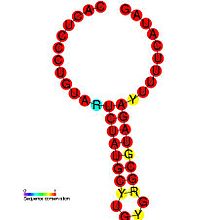Defective interfering particles (DIPs), also known as defective interfering viruses, are spontaneously generated virus mutants in which a critical portion of the particle's genome has been lost due to defective replication or non-homologous recombination.[2][3] The mechanism of their formation is presumed to be as a result of template-switching during replication of the viral genome, although non-replicative mechanisms involving direct ligation of genomic RNA fragments have also been proposed.[4][5] DIPs are derived from and associated with their parent virus, and particles are classed as DIPs if they are rendered non-infectious due to at least one essential gene of the virus being lost or severely damaged as a result of the defection.[6] A DIP can usually still penetrate host cells, but requires another fully functional virus particle (the 'helper' virus) to co-infecta cell with it, in order to provide the lost factors.[7][8]
DIPs were first observed as early as the 1950s by Von Magnus and Schlesinger, both working with influenza viruses.[9] However, the formalization of DIPs terminology was in 1970 by Huang and Baltimore when they noticed the presence of ‘stumpy’ particles of vesicular stomatitis virus in electron micrographs.[10] DIPs can occur within nearly every class of both DNA and RNA viruses both in clinical and laboratory settings including poliovirus, SARS coronavirus, measles, alphaviruses, respiratory syncytial virus and influenza virus.[11][12][13][14][15][16][17][18]
https://en.wikipedia.org/wiki/Defective_interfering_particle

No comments:
Post a Comment